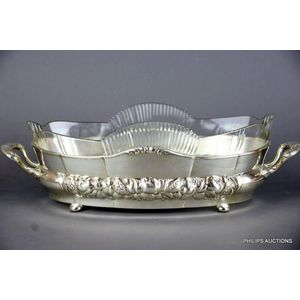Jugendstil WMF Dish with Glass Liner
A silver plated Jugendstil WMF dish with a glass liner, circa 1910, ostrich mark in beehive mark with clear top for French market, a navette shaped bowl with embossed festoons of fruiting forms, twin leafy, handles and raised on small bun feet, the original shaped glass liner with flute cuts to the rim, marked to handle, height 12.5 cm, length 42 cm, width 17 cm
You must be a subscriber, and be logged in to view price and dealer details.
Subscribe Now to view actual auction price for this item
When you subscribe, you have the option of setting the currency in which to display prices to $Au, $US, $NZ or Stg.
This item has been sold, and the description, image and price are for reference purposes only.
- Circa - A Latin term meaning 'about', often used in the antique trade to give an approximate date for the piece, usually considered to be five years on either side of the circa year. Thus, circa 1900 means the piece was made about 1900, probably between 1895 and 1905. The expression is sometimes abbreviated to c.1900.
- Jugendstil - The German and Austrian version of the Art Nouveau style and the other related styles that were expanding everywhere in Europe in the early 20th century.
The name was derived from the title of the Munich cultural magazine, "Die Jugend", with the addition of "Stil", which translates as "youth style".
Jugendstil encompasses all forms of architecture and art: industrial facilities, elevated-train systems, villas, churches, as well as the interior design of bars and coffee houses
In Austria, Jugendstil developed also in various ways, mainly under the effect of the Viennese Secession and of the Wiener Werkstätte. - Embossed / Repousse - Embossing, also known as repousse, is the technique of decorating metal with raised designs, by pressing or beating out the design from the reverse side of the object.It is the opposite of chasing, where the decoration is applied from the front. An embossed or repoussed object may have chasing applied to finish off the design.
- Navette - Navette, the French word for (weaver's) shuttle, means shuttle shaped, and is used to describe shapes in jewellery, ceramics and silver.
This item has been included into following indexes:
Visually similar items

Sheffield plate cream jug, 19th C
Sold by
in
for
You can display prices in $Au, $US, $NZ or Stg.

Silver sauce boat on hoof feet, Birmingham 1913
Sold by
in
for
You can display prices in $Au, $US, $NZ or Stg.

George III silver cream jug, . Maker: William Bateman, London 1810 145gm
Sold by
in
for
You can display prices in $Au, $US, $NZ or Stg.

A sterling silver two handled nut dish with pierced gallery border, four scroll feet and original cut glass liner. Birmingham 1929. Width 11 cm
Sold by
in
for
You can display prices in $Au, $US, $NZ or Stg.
